
By Captain Joe Birchmeier, Sergeant First Class Terry Purdin, and Sergeant First Class Ted Roberts
Deficiencies in leader/soldier knowledge of the system result from insufficient training. Because most units do not fire the line charge often and lack a complete training aid, they arrive at the NTC improperly trained in MICLIC operations. The end result is long MICLIC preparation times and high misfire rates.
Solution. The launcher must be secured with four U-bolts. If any U-bolts are missing or loose, consider the system nonmission capable.
Problem. Some units conduct a PMCS of the MICLIC system without checking the M34 blasting machine. Some units arrive at the NTC with only one operational M34.
Solution. Two M34 blasting machines should be available when the MICLIC is operated. Check the M34s with a multimeter. To be used with the MICLIC, the M34s must produce at least 222 volts DC.
Problem. Units do not check the firing cable and safety switch for continuity when they conduct a PMCS of the MICLIC without a line charge or rocket.
Solution. Use the M51 test set and a 3-inch piece of communications wire with the ends stripped. Connect the firing cable to the J1 plug (Figure 1) on the safety switch. Attach the selector switch to the other end of the firing cable. Taking the 3-inch piece of communications wire and the P1 cable, jump the pin marked "A" and the pin marked "B" (Figure 1).
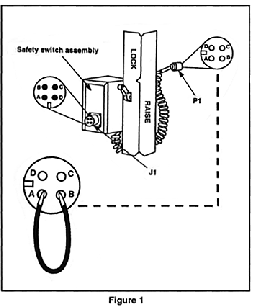
This check replicates a line charge and will check both the firing cable and the safety switch.
Note: If a light does not come on when the launcher arm is in the raised position, test the safety switch. If the safety switch is operational, the firing cable is defective.
Problem. When checking the firing cable, a light appears when the launcher arm is in the lowered position; or there is no light when the launcher arm is in the raised position.
Solution. Using a multimeter, check the safety switch. Disconnect the firing cable from the J1 plug on the safety switch (Figure 1). Look at the pin inside the J1 plug and identify the A, B, C, and D pins. Do the same on the electrical plug (P1) that hangs from the safety switch. Set the mul-timeter for OHMS to check for continuity or a closed circuit. Insert the leads from the multimeter into the A pins at the J1 and P1 plugs. When the launcher rail is in the lowered position, there should be an open circuit. Repeat the procedure for pins B, C, and D. Only pin C should have continuity. With the launcher arm in the raised position, there should be continuity in pins A, B, and C. Pin D is not used (Figure 2).
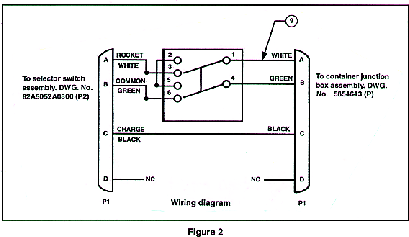
Note: If there is continuity in pins A and B in the lowered position, or if there is no continuity in pins A and B in the raised position, refer to TM 9-1375-215-14&P (pages 5-8) and adjust the roller switch lever. If the safety switch checks out after adjustment, recheck the firing cable for continuity.
Problem. The line charge is not properly secured to the trailer or the AVLM.
Solution. For the trailer-mounted MICLIC, the line charge must be connected to the trailer with four turnbuckles and locking nuts. Tighten the turnbuckles, but allow threads to show on the inside of each end. Then tighten the locking nuts to ensure that the turnbuckle will not unthread itself. Use two chains and binders for the AVLM. Pull the hook and chain through the rear line charge tie-down and attach the hook to the chain approximately 6 to 8 inches from the charge tie-down (Figure 3).
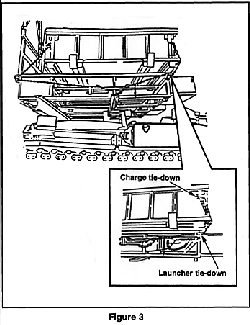
Route the chain through the rear launcher tie-down to the front launcher tie-down, up through the front line charge tie-down, and attach the hook approximately 6 to 8 inches from the charge tie-down. Install the binder under the center and ensure that the binder handle is facing rearward. After the binder is locked, secure the binder handle with tape. Repeat these steps for the other side of the charge.
Solution. Inspect the line charge as soon as it is opened. The line charge should be flush with the sides of the container. If it sinks more than 1 1/2 inches, do not use it. Return the line charge to the ammunition supply point for inspection.
Problem. TM 9-1375-215-14&P does not describe how to ensure that the arming cable will not cut the firing wire at the base of the fuze.
Solution. As part of each MICLIC preparation, pull back the nylon sock from the arming cable side of the fuze connector. Align the electrical wires on the side opposite the arming wire and neatly tape them with paper masking tape (Figure 4). Return the nylon sock to its original position.

Problem. The rocket bridle cable slips out of the cable sheath.
Solution. The improved method of taping the rocket bridle cable to the launcher rail is to tape the bridle in two places-just to the front and just to the rear of the cable sheath. Use electrical tape (Figure 5) to keep the bridle cable from moving back and forth. Ensure that the bridle forms an "S" shape when it is laid on top of the charge and connected.
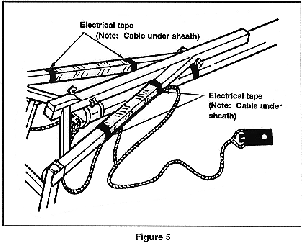
Problem. Some rockets come unlocked, due to excessive stress on the launcher rail, while traveling across rough terrain with the rocket attached to the MICLIC launcher.
Solution. Ensure that the rocket locking mechanism locks the rocket in place. Always travel with the ball-lock pins in the LOCK position. To keep the rocket secure, put some packing material from the rocket shipping container under the head of the rocket. Use a ratchet strap to secure the launcher rail with the rocket to the launcher.
Note: The strap must go over the top of the launcher rail, not just over the rocket, to prevent undue stress on the rocket.
Problem. Units travel at excessive speeds over rough terrain. Several line charge misfires at the NTC may have been caused when the charges shifted in the container before they were fired.
Solution. For trailer-mounted MICLICs, maintain speeds of 15 mph or less on improved trails and 10 mph or less when traveling cross-country; the top speed for the AVLM is 30 mph. Leaders must plan for the low speeds and coordinate with their supported maneuver units.
(1) On a trailer configuration, the launcher is connected to the trailer with four U-bolts. The line charge container is fastened with two 6-inch turnbuckles in front and two 12-inch turnbuckles in the rear.
(2) On the AVLM configuration, the launcher is connected with two U-bolts in the rear and two modified U-bolts on the center I-beam. Chain and binders are used to secure the line charge container. The binders must face rearward when closed; secure the binder to the chain with 100-mph tape.
Start the inspection at the top of the line charge:
Move to the rear of the MICLIC launcher :
(1) With the rocket in the down position, set the electrical control box selector switch to SAFE/TEST; hook up the M51 test set and depress the handle; the system should show a light. The system should not show a light when the selector switch is set on ROCKET or CHARGE. If a light is observed on the ROCKET or CHARGE setting, stop and notify the unit maintenance section.
(2) Raise the rocket from the control box and observe if it locks into position. Ensure that white marks on the inner launcher rail supports are visible but have not risen high enough for the vertical white marks (T-strips) to be seen above the outer lower launcher rail supports. Move the selector switch on the control box to ROCKET, and depress the handle of the M51. You should see a light on the test set. Move the selector switch to CHARGE and again you should see a light.
(1) The bridle cable must be in the S-curve pattern; the protective cover must not interfere with the firing operation.
(2) The bridle cables must be secured properly.
(3) The rocket ball-lock pin must be attached to the rocket or be in the hands of the crew.
(1) Valuable time is taken from, or added to, breach time by units trying to make firing the rocket and firing the charge a two-part command. Recommend that commanders give authority to fire both the rocket and the line charge when they order the emplacing engineer to move forward from an assault position.
(2) All supporting units in the battlefield must be prepared for the safety standoff when the line charge detonates.
Table 1 gives a suggested bill of materials (BOM) for MICLIC setup. Table 2 provides a suggested prescribed load list (PLL) for MICLIC operations.
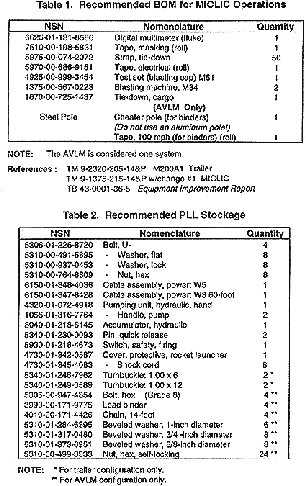
CPT Birchmeier, SFC Purdin, and SFC Roberts are assigned to Operations Group at the National Training Center, Fort Irwin, California. They are members of the Sidewinder 12 Team, working as company/platoon trainers.